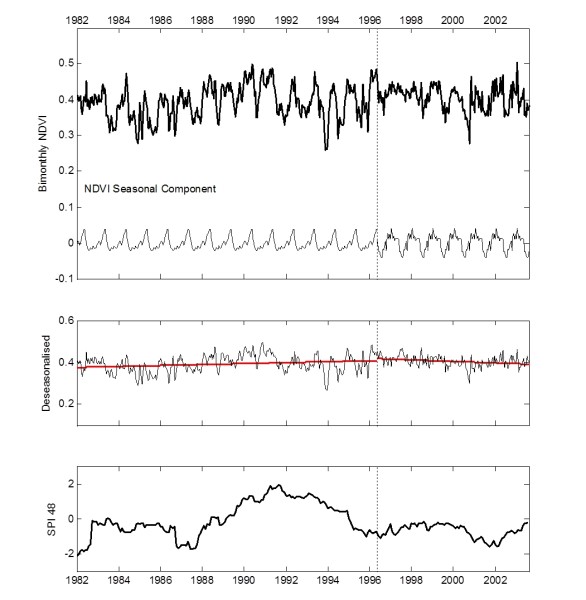| Authors: | Tsanis, I. K. and Daliakopoulos, I. N. |
| Editor: | Jane Brandt |
| Source document: | Daliakopoulos, I. and Tsanis, I. (eds) 2014. Drivers of change in the study sites. CASCADE Project Deliverable 2.2. CASCADE Report 06. 59 pp. |
The NDVI trend analysis for the Ayora reveals a break in the increasing trend that is exhibited until 1996, followed by a decrease in the average NDVI, along with a pronounced change in the variability. There is also a change of the seasonal component, with a single peak in early summer and minimum values during the winter preceding the break. On the other hand, after the trend break two peak and two minimum greenness seasons appear. Both these profiles are typical of Mediterranean woody vegetation, but a single peak may signify dependence on water availability and favorable temperatures while shrublands have minimal photosynthetically active vegetation cover and thus change in NDVI within a season is low. The timing of the seasonality change follows the occurrence of several fires (e.g. in 1979, 1984, 1991, 1994) that have resulted to a regime shift from pine forest to seeder shrubland. In addition to this observation, the timing of the seasonality change also coincides with one of the few emerging drought events in the area, highlighting the incremental effect of aridity, loss of resources and fire frequency as illustrated in the cusp catastrophe model (see »Unifying framework). It is therefore possible that the Forest Law 3/1993 was established too late to control a degradation process that was already under way.


Note: For an overview of the historical drivers of change and their analysis in all study sites see »Drivers of change in the study sites.
